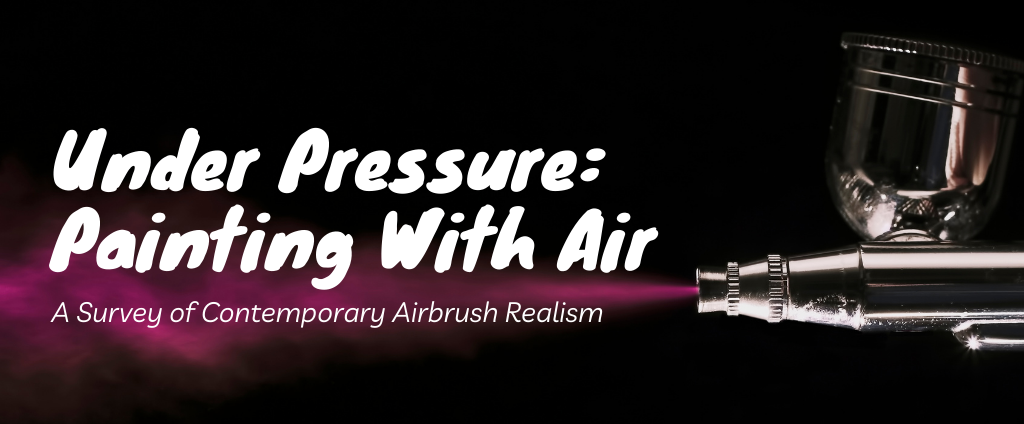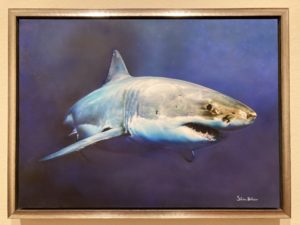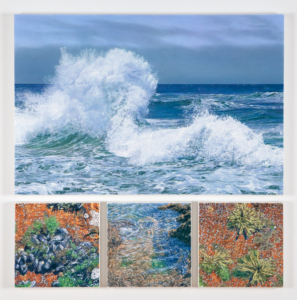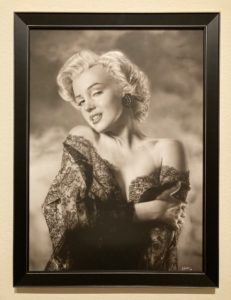
Meet the artists featured in the exhibition, Under Pressure: Painting with Air – A Survey of Contemporary Airbrush Realism, organized by David J. Wagner, LLC. This week we will highlight four of the artists on display. These artists come from all across the United States and beyond. Their works, wide-ranging in theme, all feature airbrush as the principle medium of expression.
Dru Blair
Blair, SC

Dru Blair, Floyd, 2010, acrylic on paper, 29.5 x 23.5 in.
Dru Blair grew up in Columbia, SC, and began studying medicine at Furman University in Greenville, SC. During his undergraduate studies, he discovered his artistic ability and switched majors to fine art in his senior year. He ultimately graduated with a B.A. in fine art. He later found employment in Myrtle Beach as an airbrush artist painting shirts, where his rapid success inspired him to continue his education in art at the University of South Carolina in Columbia. He earned a Masters Degree in fine art and went on to begin his career in commercial illustration.
Blair won the National Airbrush Excellence Award in 1998, which ushered in a wave of commercial opportunities. The following year, he produced his first aviation painting, “Power,” which became the first of three Air Force Magazine covers and remains the top-selling aviation print in existence. Other aviation paintings followed the advent of his own publishing company, Blair Art Studios Inc. In 1997, he founded the Blair School of Art in Raleigh, NC, which evolved into the Blair School of Realism in his ancestral hometown of Blair, SC. In 2019, he founded the Blair Center for the Arts located in Charleston, SC. He continues to sell his commissions and teaches painting workshops at his school and around the world.
In 2011, he began accepting invitations to conduct workshops in Germany, Italy, Spain, Belgium, Norway, Denmark, France, Switzerland, Austria, Ireland, Greece, the UK, Australia, New Zealand, and Russia. He discontinued these tours until 2019 so he could focus on his new school in Charleston.
Dru Blair is an Air Force Association Life Member, Honorary Member of the United States Air Force, Army Aviation Association of America Life Member, member of the North Carolina Association of Designers and Illustrators , member of the Air Force Art Program, member of the Graphic Artists Guild, Artist Fellow member of the American Society of Aviation Artists, and board member of the International Airbrush Association. He is a featured lecturer at the World Airbrush Exposition, and was the Guest of Honor at the International Airbrush Forum held in Germany, drawing over 10,000 artists from around the world. Blair continues to be featured in television shows and interviews, as well as dozens of magazine covers and book publications. Commercial projects have included popular themes such as the Budweiser Bullfrogs. Other clients include Continental Airlines, United Airlines, Proctor & Gamble, Pepsi, Coca-Cola, Nabisco, Neutrogena, Rolling Rock Beer, Rockwell International, McDonnell Douglas, McDonalds, Mattel, USA Today, and Turner Broadcasting System. He was also the official artist for Star Trek: Voyager book covers.
Silvia Belviso
Bari, Italy and Charleston, SC

Silvia Belviso, White Shark, 2017, acrylic on paper, 28 x 20 in.
Silvia Belviso was born in Bari, Italy in 1979 and, after obtaining her diploma as an art teacher at the De Nittis Art School in Bari, she immediately extended her artistic range by enrolling in the master studio Ippogrifo of the master Giuseppe “Peppino” Signorile. Ten years of uninterrupted study in this “multi-expressive” studio allowed her to deepen and experiment with many pictorial techniques. This allowed her to participate in numerous solo and group shows, both national and abroad.
“It was such a blessing for me to know my maestro Giuseppe “Peppino” Signorile. He dedicated his entire life to art, traveling around the world and meeting famous Italian artists such as Picasso, Renato Guttuso and many others. He is known for his poetic paintings; beautiful landscapes which have been displayed in many different places in the world including Nuremberg, Prague, Montenegro, Germany and Italy. He was the last artist in my own city to have a “bottega”, a studio in the style of the old Florentine studios in the Renaissance where artists studied with the maestro and experimented with different techniques of painting, sculpting, making mosaics, and gold leafing.”
She began her specialization in painting techniques in 2003 in Florence, and then went on to Rome where she actively collaborated with the Italian Airbrush Association. She continued her career as a painter, teacher, and organizer of national art exhibitions for emerging and non-emerging artists.
Since 2014, she has been perfecting her skills in portrait, custom, automotive and hyper-realistic painting at the Blair School of Art in South Carolina.
Don Eddy
New York, NY

Don Eddy, I Am Water, 2019, acrylic on canvas, 36.25 x 36 in.
Don Eddy is a contemporary representational painter. He gained recognition in American art around 1970 amid a group of artists that critics and dealers identified as Photorealists or Hyperrealists, based on their work’s high degree of verisimilitude and use of photography as a resource material. Eddy has worked in cycles, which treat various imagery from different formal and conceptual viewpoints. His work moved from detailed images of automobile sections and storefront window displays in the 1970s, to perceptually challenging mash-ups of still lifes and landscapes scenes in the 1980s, and then to mysterious multi-panel paintings in his latter career.
Artist Statement:
My paintings and drawings use photographs as source material. I take all the photography and print each photograph. I use a number of tools (Photoshop, Viveza, DxO Perspective, etc.) to alter the raw images. This gives me thorough control over the resource material. I often use a wide variety of photographs to satisfy my needs relative to a given panel. There may be a number of prints with different value and/or color structures or focal planes.
My primary painting tool is my 59-year-old airbrush. The paintings grow out of a somewhat complex under and over-painting process. First, I create an initial drawing to transfer the relevant information to the painting surface. I then begin the underpainting process using the airbrush. The underpainting process is divided into three parts, each determined by a specific color. I use Phthalocyanine Green in the first stage. While there appears to be detailed information, in fact, no imagery is rendered in this stage. I make tiny circles of approximately 1/16th of an inch, each having a specific value. At a distance these circles coalesce into what appears to be imagery. For the second stage, I use Burnt Siena to establish a very basic color system, separating the areas that will be cool from the areas that will be warm. I use Dioxazine Purple in the third stage to further subdivide the color structure. This allows me to separate greens from blues (on the cool side) and reds from yellows (on the warm side). I also lay out the black and grays at this stage.
The colors in the underpainting stages are transparent or translucent. The system is alive in that any given color is the product of many layers of various transparent colors. In a similar way, the value of a color is determined by the density of those layers. White is simply the primed canvas and light colors are light because more of the canvas is showing through the veils of paint. The finished underpainting yields a rough approximation of the final color and image structure that will become the completed painting.
When the underpainting is complete, I embark on the overpainting stage. The overpainting stage is even more elaborate than the underpainting process. The number of layers in the overpainting stage generally range from ten to twenty. My goal is to establish the exact hue, value, and intensity of each color area without losing the optical richness that is derived from the transparent multilayered painting system.
David Evanoff
Cleveland, GA

David Evanoff, Day Dreaming, 2019, acrylic on synthetic paper, 27 x 19 in.
David Evanoff started painting at a young age and has never stopped. He earned a bachelor’s degree in Graphic Design from The University of Akron, and then spent a year in the graphic design field before deciding it was not his passion. “I got into the art field because I like to paint and draw, not push type around,” he explains. In 1995, Evanoff started his own airbrush business and successfully ran it for over 20 years. He has painted just about every subject matter on a multitude of surfaces: t-shirts, canvases, floors, walls, helmets, motorcycles and cars. A year ago, Evanoff sold his business and started painting full time. His true passion lies in painting realistic to hyper-realistic people, figures, and animals.
“I like color, but I love the simple elegance of monochromatic portraits and figures, the subtle plays of lights and darks, and the reflected light bouncing around the face. Then, I allow more creativity to flow by taking that simple elegance and adding movement and pop by splashing color in the background and moving it into the face.”

